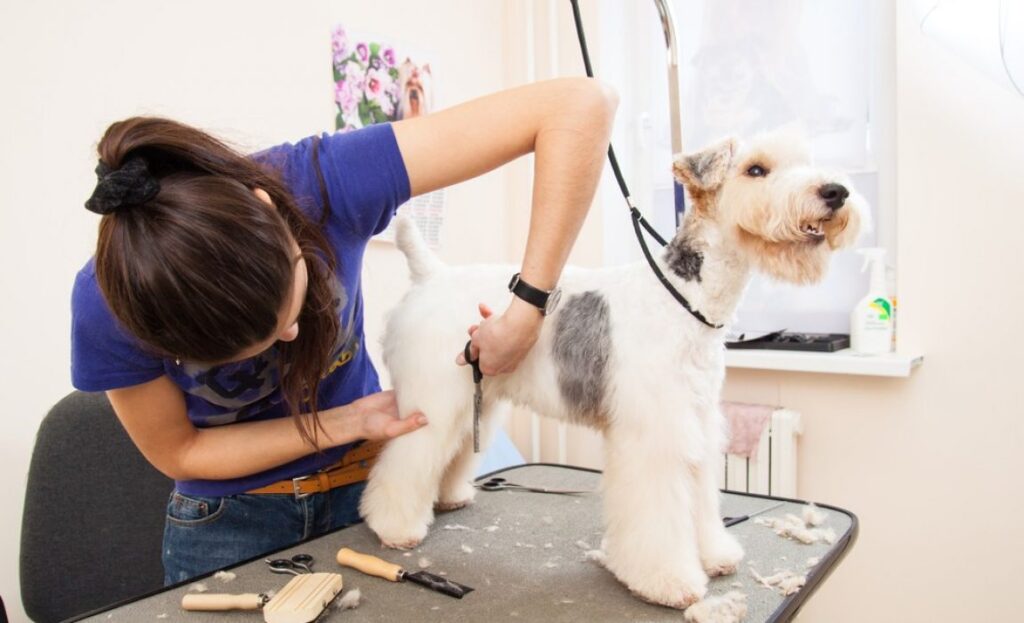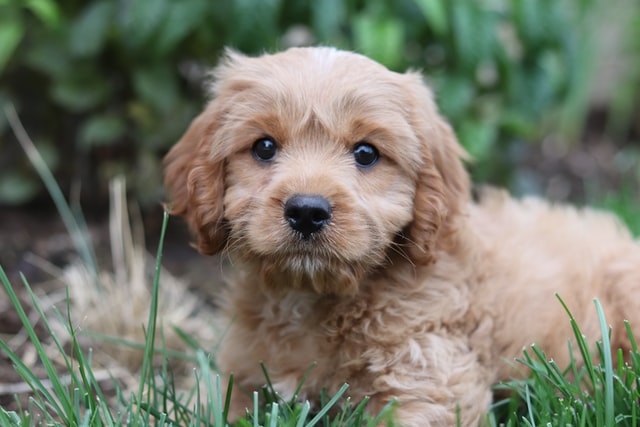Throughout any dog’s life, most will experience a wide variety of handling by humans. It’s important however, that a dog is comfortable with human handling as we are the ones providing routine care for them. Routine care – that is, going to the vet or groomer, having nails trimmed or being bathed, needing to take medication or have drops put in their ears… these are all referred to as animal husbandry tasks. Many dogs, for whatever reason, have developed anxiety and fear based around husbandry care. As a new puppy owner you have the opportunity to start your puppy out on the right foot… or should I say, paw! Helping your puppy learn to be comfortable with human handling will also help to make grooming your puppy a positive experience… one met with calmness and confidence instead of fear and aggression.
PRACTICE HANDLING AT HOME
In order to help your puppy become comfortable and accepting of human handling, several times a day spend some time gently, but deliberately, handling your puppy. I know… who actually needs to be told to handle their puppy? I should probably say, instead, remember your puppy needs some time to themselves so they can sleep too! All kidding aside… handling their paws, mouth, teeth, nails, ears, etc., allows the puppy to develop positive experiences around human handling. Don’t wait until you are going to be taking your puppy to the groomer… start now! The more time they have to get used to handling, the more comfortable they will feel.
So, with the ultimate goal of having a calm and relaxed puppy at the groomer, here are some simple tips to help introduce your puppy to some handling that will happen at the groomer.
NAILS
Nail trims are something that puppies and dogs of all ages need to have done. If nails are neglected and get too long it can have serious short and long term consequences for your dog. When a dog is fearful or anxious with a handling task such as having their nails trimmed, it’s not only difficult situation for your dog, it creates a potentially dangerous situation for the groomer. The sooner you’re able to begin teaching your puppy that having their paws and nails touched is a positive thing, the better it will be for your puppy… and the groomer.
In general, puppies don’t like having their paws touched. It’s instinctual for them to pull back their paw when we try to touch them. To help with that, you can rub their paws, or place your hand on their paws when you’re cuddling with them. After each time you handle their paws, give them praise… and a treat. If you aren’t familiar with the term, this is what positive reinforcement is… and it will make your puppy more willing to let you touch their paws again. These simple steps, if started early, helps to teach your puppy that it’s okay when people touch their paws.
From a groomer’s standpoint, it’s important that your puppy remains as still as possible when getting their nails trimmed. A dog’s nail has what’s called a ‘quick’. The quick runs through the center of the nail and is the nail’s blood supply. If your puppy is constantly pulling their paw back, it increases the risk of the groomer (or you, if you are trimming nails yourself) accidentally cutting the quick. This will not only cause your puppy’s nail to bleed, it will be uncomfortable. Cutting the quick is one of those things that can easily cause fear and anxiety the next time they need their nails trimmed.
EARS
Certain breeds require more maintenance when it comes to ear care as some will need to have ear hair plucked and clippers or scissors used to trim around their ears. A puppy that is moving or uncomfortable with people handling their ears makes it more challenging for the groomer, and increases the risk of the puppy being hurt. What if your puppy was to develop an ear problem, or an infection? It would be beneficial to have them comfortable with having their ears handled as you may have to insert drops in their ears. To help, massage your puppy’s ears and gently hold them in your hand. You can flip them up and back as if you were to be looking inside their ear. Just like with their nails… with each time you handle their ears, praise your puppy and give them a treat.
BRUSHING
Brushing is an important part of maintaining a healthy coat, short or long, and it’s a great way to spend a little quality time with your puppy. If you make it routine, most dogs love to be brushed and it removes the undercoat and fine hairs that are shed naturally. Want less hair around your house… on your clothes… in your food (LOL)?? Regular brushing will help with that!
For breeds that have longer or thick coats, brushing also reduces the frequency of matting. Matting is when their fur gets tangled and knotted. If mats are neglected they can actually become quite painful for your puppy or dog as they can pull on the skin. Mats also trap moisture creating an ideal environment for sores or skin irritation. Once again, just like with their paws and ears – and any new experience – when brushing your puppy provide them with praise and treats.
CHOOSING A GROOMER

For new puppy parents, the first grooming experience is often comparable to taking a child for their first hair cut. It’s a big deal! For your puppy, this experience will set the tone for future grooming sessions – be it positive or negative. The hard work that you are doing at home with handling however, is only one part of creating a positive grooming experience. The other piece of the puzzle comes with the groomer that you choose.
Like any profession, there are different calibers of groomers. When looking for a groomer for your puppy, it’s a good idea to look for one that will book short sessions to slowly introduce the grooming process. The first appointment, which should generally be around 12 week of age (your puppy should be fully vaccinated), may involve spending some time on the table, getting brushed and hearing some of the sounds in a grooming salon. The next appointment may be for a bath and a brush… and maybe a trim, even if they don’t really need it. Each appointment introduces a little more, depending on your puppy’s grooming needs.
Not all groomer will take this approach. Some salons treat grooming dogs as an assembly line process… and others take a more personal approach based on the individual dog’s needs. Do your research and ask questions to determine the type of groomer you feel comfortable trusting your puppy with.
What else should you look for in a grooming salon? Having been a professional pet groomer… here are a few tips that I would recommend that you take into consideration in your search:
ASK FOR A TOUR
In most salons, the grooming area will not be visible from the lobby, leaving clients unable to see where the grooming takes place. Don’t be shy about asking if you can see their facility. Remember, you’re thinking about trusting them with grooming your puppy. In the end, you really should feel comfortable with the whole facility. If staff are reluctant to give you a tour, you may want to consider this as a possible red flag. If you do get a tour, pay attention to things like:
- is the facility clean?
- does it smell clean?
- is it well lit?
- is the area well ventilated?
- are the products they are using pet friendly?
- where are the dogs kept when they are not on the table (they should be in crates – which should be clean and in the view of staff in case of a problem)
WHATS SERVICES ARE INCLUDED?
Inquire about their services and what their fee structure is, including any extra fees for things like de-matting as this can add up quickly! Some breeds also take longer to groom so extra fees may be added on and they may not share this information up front. For example, grooming a Golden Retriever is faster than grooming a Standard Poodle! You may have a puppy right now, but depending on your breed, this is something that you should be aware of to avoid surprises.
BREED SPECIFIC EXPERIENCE
Be specific with the groomer if you want a particular haircut for your puppy. If you have a breed like a Bichon Frise and want a traditional cut, be sure to ask the groomer if they have experience with your breed. There are a lot of groomers out there that seem to only know how to do a ‘puppy cut’ or almost shave your puppy. It is best that you know these things before hand to avoid shock and disappointment after it’s too late. If you find you are nervous about leaving your puppy for the first visit, ask if you can stay and watch. It may not be the most convenient for the groomer, but your request is not unreasonable. It is important that the groomer does what they can to accommodate your needs… as well as your puppy’s.
TRAINING & CREDENTIALS
Don’t be afraid to ask about a groomer’s training. Some groomers learn on the job, but others attend classes at a professional pet grooming school and come out with a certification. Asking questions will allow you to get a feel about the groomer’s experience and knowledge. It’s also a good idea to ask if anyone on staff is trained in pet first aid.
LIABILITY INSURANCE
Unfortunately in life accidents happen, and liability insurance could be another thing to think about. If, for any reason, your puppy is injured while under the care of the groomer or the facility, any expenses related to the injury should be covered by liability insurance. Better to be safe than sorry.
In the end, have fun with your puppy – this time goes by quickly! While you’re here, be sure to download our FREE Puppy Socialization Checklist and include socialization outings with your puppy a few times each week. Socialization plays a big role in ensuring your puppy grows into a well-adjusted, happy companion for you and your family.







0 Comments